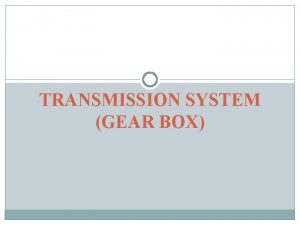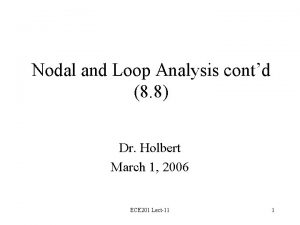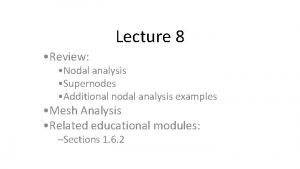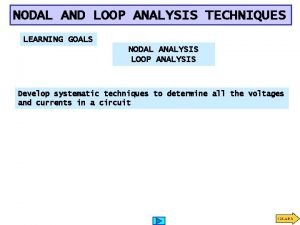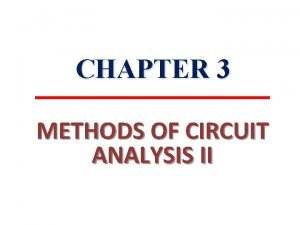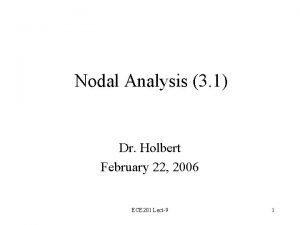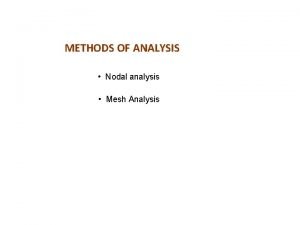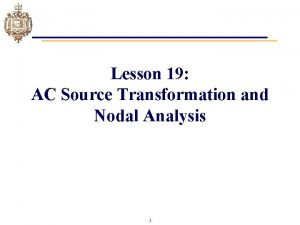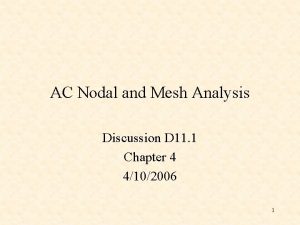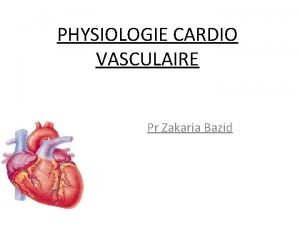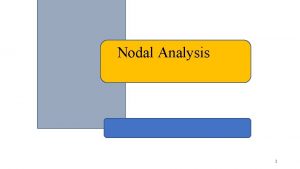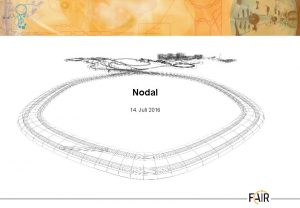METHODS OF ANALYSIS Nodal analysis Mesh Analysis Mesh













- Slides: 13

METHODS OF ANALYSIS • Nodal analysis • Mesh Analysis

Mesh Analysis An analysis technique to solve electrical circuit where the mesh currents are used as the circuit variables A loop which does not contain any other loops within it R 1 V 1 R 2 R 3 meshes V 2

Mesh Analysis An analysis technique to solve electrical circuit where the mesh currents are used as the circuit variables A loop which does not contain any other loops within it It involves systematic steps with an objective to solve the mesh currents mesh current is not branch current ! If all mesh currents are known, the circuit can be solved V 1 R 2 + v 1 + v 2 i 1 + v 3 R 3 i 2 io i 1 & i 2 are mesh currents v 1 = R 1 i 1 V 2 v 2 = R 2 io = (i 1 - i 2) v 3 = R 3(i 1 - i 2)

Mesh Analysis Mesh analysis only applicable to planar circuit Mesh analysis cannot be applied to nonplanar circuit Note: Nodal analysis is applicable to planar and nonplanar circuit Planar circuit: A circuit that can be drawn on a plane with no branches crossing Planar circuit

Mesh Analysis Mesh analysis only applicable to planar circuit Mesh analysis cannot be applied to nonplanar circuit Note: Nodal analysis is applicable to planar and nonplanar circuit Planar circuit: A circuit that can be drawn on a plane with no branches crossing nonplanar circuit

Mesh Analysis Mesh analysis only applicable to planar circuit Mesh analysis cannot be applied to nonplanar circuit Note: Nodal analysis is applicable to planar and nonplanar circuit Planar circuit: A circuit that can be drawn on a plane with no branches crossing ?

Mesh Analysis Mesh analysis only applicable to planar circuit Mesh analysis cannot be applied to nonplanar circuit Note: Nodal analysis is applicable to planar and nonplanar circuit Planar circuit: A circuit that can be drawn on a plane with no branches crossing ?

Mesh Analysis 36 V 2 9 i 1 i 2 4 12 24 V 3 Step 1 Assign mesh currents to the meshes Step 2 For every mesh, apply KVL – Using Ohm’s law, write down the equations in terms of mesh currents Step 3 Solve mesh currents in equations obtained in step 2, simultaneously

Mesh Analysis 4 k Example 2 i 1 6 V 6 k + 9 k i 2 3 k i 3 12 k Step 1 Assign mesh currents to the meshes Step 2 For every mesh, apply KVL – Using Ohm’s law, write down the equations in terms of mesh currents Step 3 Solve mesh currents in equations obtained in step 2, simultaneously

Mesh Analysis Verification using Pspice 4 k Example 2 1 6 V + 9 k 2 3 k 0 Netlist: Mesh example 2 R 1 0 1 9000 V 1 2 1 DC 6 R 2 2 0 3000 R 3 1 3 4000 R 4 2 3 6000 R 5 3 0 12000. DC V 1 6 6 6. PRINT DC I(R 1) I(R 3), I(R 5). END 6 k 3 12 k

Mesh Analysis Example 2 Verification using Pspice

Mesh Analysis Example 3 6 V 4 k + + 2 k i 1 i 2 + 3 V 6 k Using mesh analysis, solve vo vo Step 1 Assign mesh currents to the meshes Step 2 For every mesh, apply KVL – Using Ohm’s law, write down the equations in terms of mesh currents Step 3 Solve mesh currents in equations obtained in step 2, simultaneously

Mesh Analysis 5 A Example 4 i 3 8 Using mesh analysis, solve i 1, i 2 2 1 i 1 40 V + 4 i 2 + 20 V Step 1 Assign mesh currents to the meshes i 3 is already solved i. e. i 3 = 5 A Step 2 For every mesh, apply KVL – Using Ohm’s law, write down the equations in terms of mesh currents Step 3 Solve mesh currents in equations obtained in step 2, simultaneously
 Sliding mesh vs constant mesh
Sliding mesh vs constant mesh Advantages of nodal analysis
Advantages of nodal analysis Supernodes nodal analysis
Supernodes nodal analysis Site:slidetodoc.com
Site:slidetodoc.com Nodal analysis steps
Nodal analysis steps Mesh analysis
Mesh analysis Nodal analysis
Nodal analysis Nodal analysis
Nodal analysis Source transformations
Source transformations Nodal analysis
Nodal analysis Given the circuit below, find vo using nodal analysis.
Given the circuit below, find vo using nodal analysis. Ac mesh analysis
Ac mesh analysis Tissu nodal localisation
Tissu nodal localisation Sarcoplasme
Sarcoplasme
